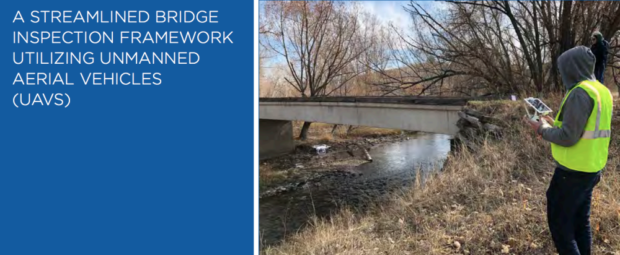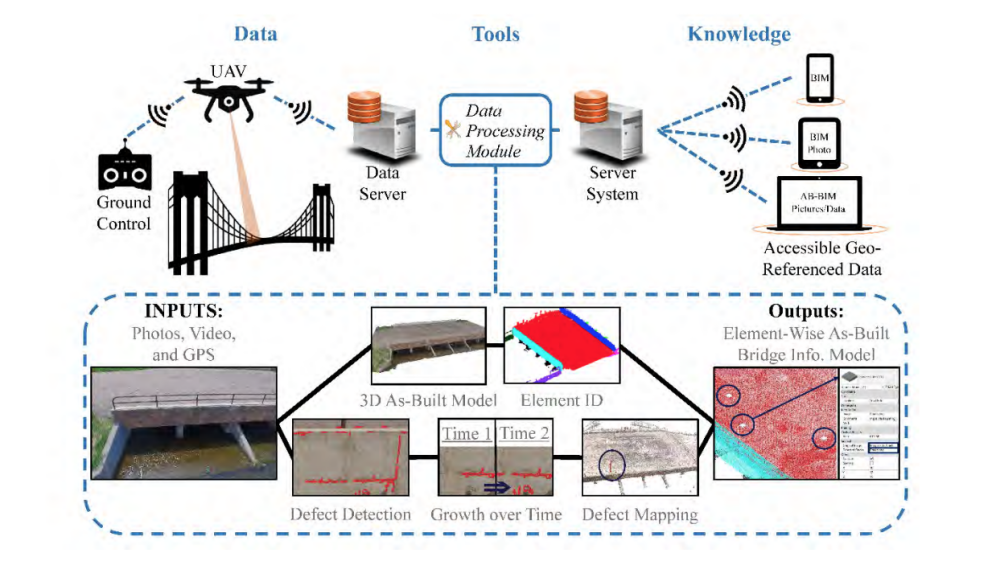A Report on a Bridge Inspection Study Using Unmanned Aerial Vehicles and Automated Image Processing Investigated Inspection Productivity in Colorado, prepared by Colorado State University for Mountain-Plains Consortium* has just been released.
One of the main findings was that on-site time for bridge inspection with an automated system utilizing UAVs was estimated to take two hours compared with two weeks for traditional human-based inspection techniques.
Summary Information
The use of commercially available Unmanned Aerial Vehicles (UAVs) has facilitated bridge inspections by collecting images showing the condition of the bridge. However, gathering precise measurement of the size of a structural defect, growth patterns, and exact location by looking at the collected images can be a challenging task. Researchers in Colorado investigated a streamlined bridge inspection system with an advanced set of data analytics tools to automatically identify type, extent, growth, and 3-D location of defects using computer vision and machine learning techniques.
The study established a georeferenced, elementwise, as-built bridge information model (AB-BrIM) to document and visualize damage information. The efficacy of the proposed system was assessed using two bridges in Colorado. The images and data collected from the Palmer Bridge (a bridge with six concrete box girders) was used and analyzed to demonstrate the potential of UAV-enabled bridge inspections. The flights at the Oxbow Bridge (a bridge with high clearance) were used to demonstrate the systems used and the feasibility of flying under a structure and collecting upward-angled imagery of the underside of the structure.
Methodology
Four different flights were used in this study, with two flights manually controlled and two autonomously flown. In the manually-controlled flights, two flying techniques were tested: flying parallel to the traffic flow and flying perpendicular to the traffic flow. In order to create the 3-D base for the AB-BrIM, a photogrammetry technique was utilized, as it could provide a cost-effective system with longer battery life and no additional equipment required.
To evaluate the efficiency and advantage of the proposed bridge inspection system, it was compared with two existing techniques; traditional human-based inspection, and UAV-assisted inspection without automated image processing.
Findings
Results obtained in this study indicated that the tested system, which only requires minimal user inputs, could reduce the on-site time for bridge inspection. Traditional human-based techniques were estimated to require two weeks of on-site time as compared to two hours for the UAV-assisted methods. Although traffic control is still required with UAV-assisted inspections, the duration could be similarly reduced.
Computing time for the UAV-assisted inspection system with automated image processing was higher than human-based methods and existing UAV-assisted techniques with manual defect detection from images. However, the automated processing algorithms can run autonomously or be left overnight, which could reduce report generation time for the inspector.
With the tested system, additional photos and quantified damage information in successive inspections can allow for more objective comparisons with information from prior inspections.
The full 59-page report can be accessed here: A Streamlined Bridge Inspection Framework Utilizing Unmanned Aerial Vehicles (UAVs)
*Consortium Members:
Colorado State University
North Dakota State University
South Dakota State University
University of Colorado Denver
University of Denver
University of Utah
Utah State University
University of Wyoming


